Oh, and Gerhard, yes I will strip and clean carby and while there I'll see what jets are in it and replace or not...accordingly.
The story so far
-
lane1feathers
- Posts: 258
- Joined: Thu Sep 20, 2012 11:48 am
- model: 906 Paso
- year: 1989
- Location: Perth, West. Australia
Re: The story so far
Sintered pads...check 
Oh, and Gerhard, yes I will strip and clean carby and while there I'll see what jets are in it and replace or not...accordingly.
Oh, and Gerhard, yes I will strip and clean carby and while there I'll see what jets are in it and replace or not...accordingly.
Lane
89 Dark Blue 906 Paso
Ducati Paso, It's an 'understanding'....
89 Dark Blue 906 Paso
Ducati Paso, It's an 'understanding'....
-
lane1feathers
- Posts: 258
- Joined: Thu Sep 20, 2012 11:48 am
- model: 906 Paso
- year: 1989
- Location: Perth, West. Australia
Re: The story so far
HEL braided lines...check. Thanks 907pasonut 
Lane
89 Dark Blue 906 Paso
Ducati Paso, It's an 'understanding'....
89 Dark Blue 906 Paso
Ducati Paso, It's an 'understanding'....
- JWilliam
- Posts: 331
- Joined: Wed Oct 06, 2004 12:00 am
- model: 906 Paso
- year: 1989
- Location: Nottingham, UK
Re: The story so far
Er... Mr Potato Head doesn't use sintered pads with a cast iron rotor. I already said that I changed the pads to sintered when I changed to carbon-steel rotors. Previous was organic pad with cast-iron rotor. I wouldn't make a newbie mistake like that. Carbon-steel rotors work a good few hundred degrees hotter that cast iron and aren't affected by wet weather. Is there any other part of the post that you think was iBS?higgy wrote:Pure bullshit, Sintered pads are the issue with cast iron rotors. the only advantage to stainless rotors is their corrosion resistance period. As a friction material they suck the big one. Truth is any non-sintured as in organic pad will give you superior braking with iron rotors. Got two pistons just get a set of braided steel lines and don't use Sintered pads
- englishstiv
- paso grand pooh-bah
- Posts: 1117
- Joined: Wed Apr 09, 2008 9:57 pm
- model: 907 I.E.
- year: 1992
- Location: Manchester, England.
Re: The story so far
_________________higgy wrote:
Pure bullshit, Sintered pads are the issue with cast iron rotors. the only advantage to stainless rotors is their corrosion resistance period. As a friction material they suck the big one. Truth is any non-sintured as in organic pad will give you superior braking with iron rotors. Got two pistons just get a set of braided steel lines and don't use Sintered pads
Er... Mr Potato Head doesn't use sintered pads with a cast iron rotor. I already said that I changed the pads to sintered when I changed to carbon-steel rotors. Previous was organic pad with cast-iron rotor. I wouldn't make a newbie mistake like that. Carbon-steel rotors work a good few hundred degrees hotter that cast iron and aren't affected by wet weather. Is there any other part of the post that you think was iBS?
errr maybe this will help?????
http://www.google.co.uk/imgres?imgurl=h ... EA&dur=524
Time Gentlemen please......
DUCATI 907ie 1992
HARLEY DAVIDSON ELECTRA GLIDE CLASSIC 1991
Ducati Streetfighter 955 V2
HARLEY DAVIDSON ELECTRA GLIDE CLASSIC 1991
Ducati Streetfighter 955 V2
-
lane1feathers
- Posts: 258
- Joined: Thu Sep 20, 2012 11:48 am
- model: 906 Paso
- year: 1989
- Location: Perth, West. Australia
Re: The story so far
...organic pads...check 



I'M SO CONFUSED Lol
Lol
I'M SO CONFUSED
Lane
89 Dark Blue 906 Paso
Ducati Paso, It's an 'understanding'....
89 Dark Blue 906 Paso
Ducati Paso, It's an 'understanding'....
- higgy
- paso grand pooh-bah
- Posts: 3377
- Joined: Tue Jul 29, 2008 9:50 pm
- model: 907 I.E.
- year: 1992
- Location: Hilltown,Pennsylvania
- Contact:
Re: The story so far
Traditional iron brake rotors such as widely employed in the automotive industry and to a much lesser extent, in the motorcycle aftermarket are Gray iron. That material is features a distinctive coarse flake molecular structure and typically suffers from issues of porosity that can lead to failures associated with thermal stress induced fracturing. To address these inherent material weaknesses, improve their failure resistance and increase thermal capacity, they are typically big and heavy. This whole reliability issue is made worse by the nearly universally employed individual mold casting technique...cheap and efficient to be sure, but also guarantee's even more problems associated with uncontrolled porosity.
The widely reported untimely demise of Jimmie Adamo is much as described, but that too was Gray iron and simply not up to the task.
The Ductile iron family is a different animal, developed in the mid 1940's specifically to deal with the inherent brittleness of Gray iron. Ductile iron features a unique spheroid - nodular molecular structure that introduced "ductility" into the matrix. This brought many benefits to the manufacturing industry with a much more reliable base material including substantially higher tensile strength, inherent resistance to thermal stress induced fracturing, improved thermal conductivity and more. Within that broad family of Nodular (ductile) iron, there are many variations, just like there are in the general steel family. Without getting too boring with unnecessary minutia, suffice to say the specific grade of iron used in the manufacture of BrakeTech AXIS/Iron rotors is an optimal alloy with a closely monitored and proprietary heat-treating process employed for both stress relieving and material hardness. We also utilize a specialized in-house Cryogenic treatment of LN in a computer control vapor system at -300F. Contrary to what is out in the ether sphere of the web, the cryo processing we employ converts austenitic carbon/graphite atoms to martensitic for much improved wear (abrasion) resistance. Our testing shows the cryo processing has little real-world affect on relieving residual material stresses. That aspect of manufacture is addressed in our proprietary and more traditional heat-treating.
Also, unlike the individually molded Gray iron mentioned at the outset, the BrakeTech ductile iron is manufactured from true billet, no individual molding here. We quite literally saw blanks from continuous cast bar containing virtually zero porosity. Every step of manufacturing is closely monitored to a remarkably high level and ISO 9001 standards (each finished iron blade is micro laser etched with all relevant batch and date info, look closely at the patented and trademarked Direct-Link "tooth" and you'll find that).
Quick note on perceived weight of iron versus stainless; contrary to popular belief, the misconception that iron is heavier than stainless steel is simply not true. The density of iron is slightly lower than that of common stainless, so for a given volume of material, iron will be somewhat lighter. Perception always plays a role; kinda like asking an unsuspecting friend, “which is heavier, a pound of feathers or a pound of lead?”
Lastly, the real reason the OE's don't use iron is primarily one of aesthetics; the potential of rusting rotors is very simply not palatable. A secondary reason is the greater expense of manufacturing from a proper grade of higher spec ductile iron, costs are always an issue. And lastly, advances in friction material technology for use on stainless steel have come a long way, their performance as well all know is nothing short of brilliant...it's just a bit better still on iron!
My apologies for the lengthy response...it's a convoluted subject so "sound bite" like replies doesn’t cut it.
Best wishes and safe riding to all.
Jeff Gehrs
BrakeTech USA
Iron Brake Rotors - Ducati.ms - The Ultimate Ducati Forum
If it was a pure performance decision, the decision would go to iron.


Ducati,making mechanics out of riders since 1946
There's no problem so bad that a little fixing can't make it worse! : )
Electrocuted Birds Are Bursting Into Flames and Starting Wildfires
88 750
90 906
92 907ie
There's no problem so bad that a little fixing can't make it worse! : )
Electrocuted Birds Are Bursting Into Flames and Starting Wildfires
88 750
90 906
92 907ie
-
lane1feathers
- Posts: 258
- Joined: Thu Sep 20, 2012 11:48 am
- model: 906 Paso
- year: 1989
- Location: Perth, West. Australia
Re: The story so far
I think I might just keep the iron ones...this is all very informative. Thanks for your opinions fellas.
Lane
89 Dark Blue 906 Paso
Ducati Paso, It's an 'understanding'....
89 Dark Blue 906 Paso
Ducati Paso, It's an 'understanding'....
- ducinthebay
- paso grand pooh-bah
- Posts: 1323
- Joined: Sat Sep 03, 2005 12:00 am
- model: 750 Sport
- year: 1990
- Location: SF Bay Area
Re: The story so far
yep, iron rotors still rock. Still the top of heap for rotor material. Match the right pads, and you will be in love. I have found that the iron rotors are more progressive than the stainless set up I had, which is better to get the right amount of braking for the situation. I found the stainless rotors with EBC HH sintered pads had really hard initially bite, but didn't do much the harder I pulled, at least compared to the Brembo iron rotors with Forrodo pads that I am running now. I got a little bit of tire slip on a few occasions on the old brakes making a quick input in a panic situation. The cast iron is more forgiving, more controllable, and gives me a shorter stopping distance. Hmm, just better, as long as you can deal with the rust from time to time.
Cheers, Phil
Cheers, Phil
Duc in the Bay
1990 750 Sport x2-Rosso Blanko (900ss copy) & Nuovo Nudo (Scrambler project)
1991 907 -mostly stock
2002 ST4s - Lots of mods.
1990 750 Sport x2-Rosso Blanko (900ss copy) & Nuovo Nudo (Scrambler project)
1991 907 -mostly stock
2002 ST4s - Lots of mods.
-
lane1feathers
- Posts: 258
- Joined: Thu Sep 20, 2012 11:48 am
- model: 906 Paso
- year: 1989
- Location: Perth, West. Australia
Re: The story so far
Well, I had a free day today so I tackled the fork seals. I had ordered the dust seals from Gowanloch and thought they would be here today...but they weren't.  so I got as far as I could.
so I got as far as I could.
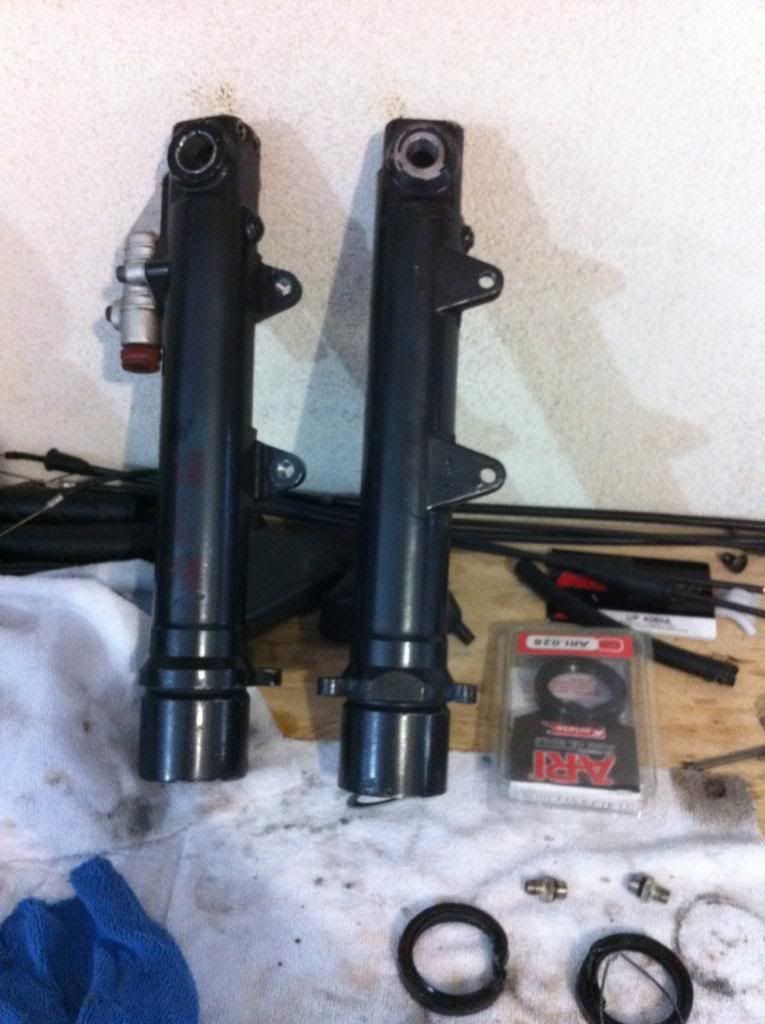
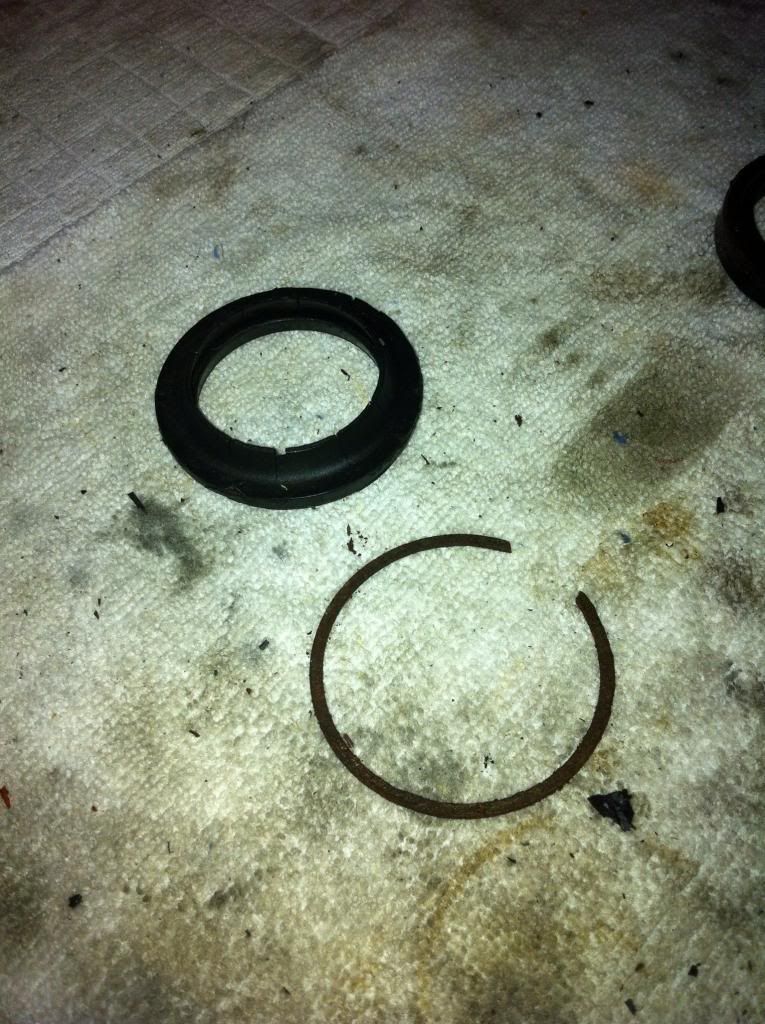
Check out the condition of the rubbers! and the rusty retaining rings!
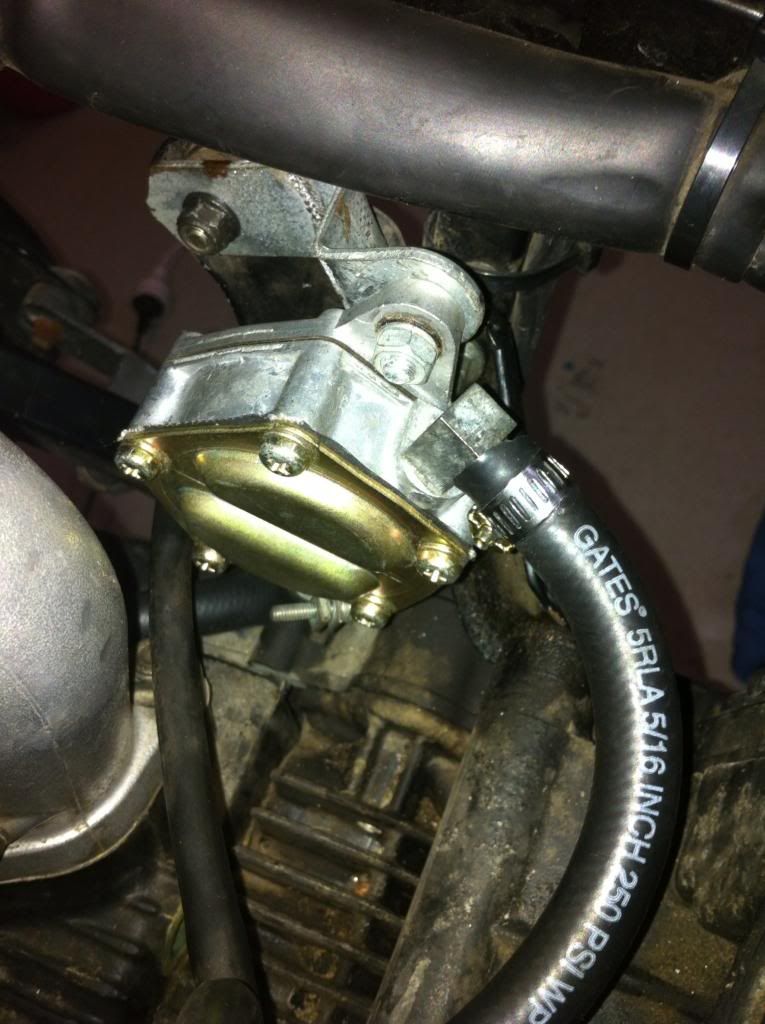
Mounted the vacuum fuel pump where the elec. one was...just incorporated a bracket as the holes didn't line up and this allows it to be secured on the right angle.


Check out the condition of the rubbers! and the rusty retaining rings!

Mounted the vacuum fuel pump where the elec. one was...just incorporated a bracket as the holes didn't line up and this allows it to be secured on the right angle.
Lane
89 Dark Blue 906 Paso
Ducati Paso, It's an 'understanding'....
89 Dark Blue 906 Paso
Ducati Paso, It's an 'understanding'....
-
lane1feathers
- Posts: 258
- Joined: Thu Sep 20, 2012 11:48 am
- model: 906 Paso
- year: 1989
- Location: Perth, West. Australia
Re: The story so far
...got the stanchion tubes off the bike, disassembled forks completely and cleaned thoroughly.
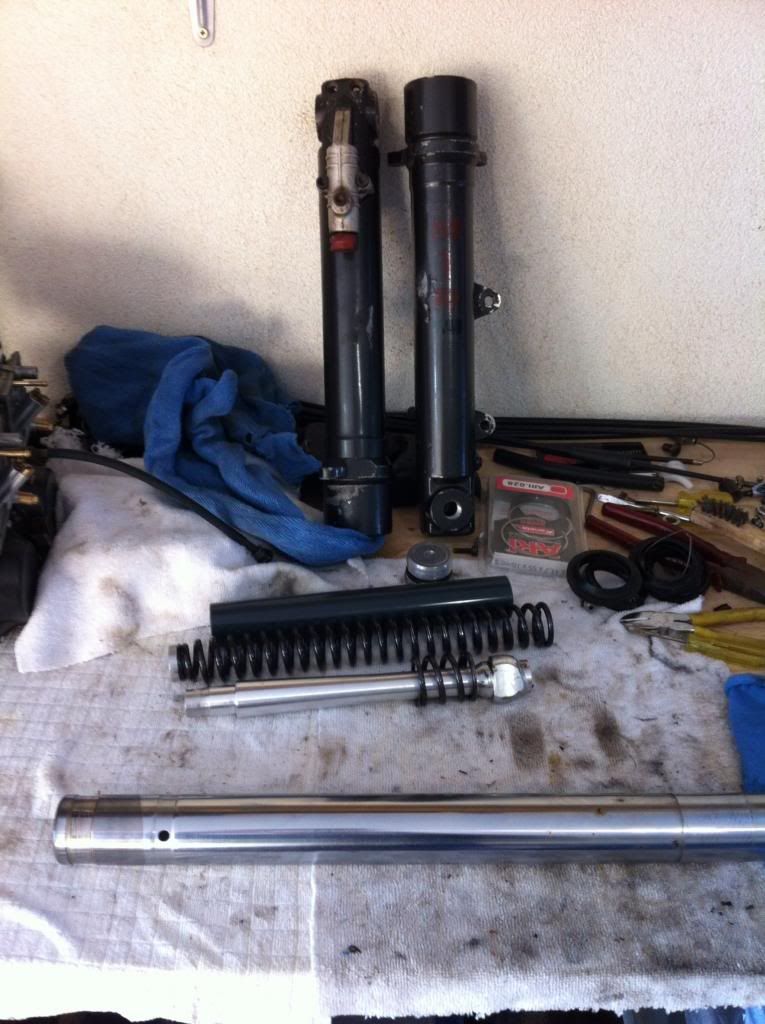
Got new seals in with the use of some PVC tube courtesy of the neighbor
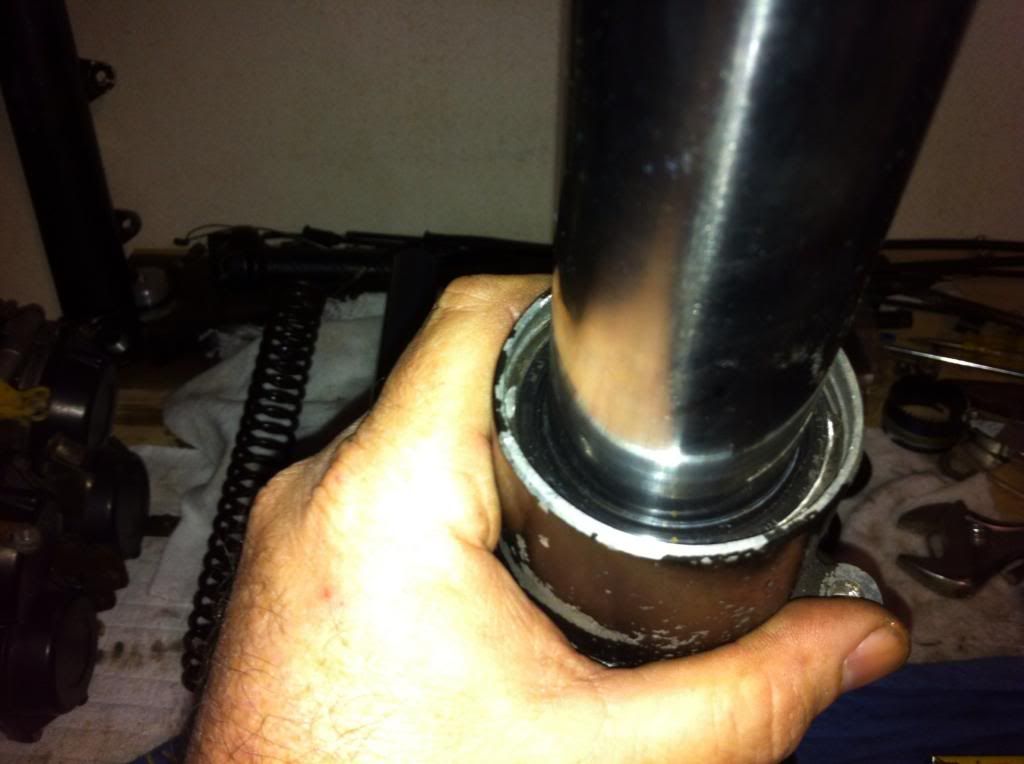
With the springs and spacers removed and the forks fully compressed I filled the fork with oil almost to the top. I then inserted my newly made precision tool (I call it the "fork oil level reduction tool") and sucked until I got air. Tube is cut at 180mm and supported with a steel rod...works mint and cost nothin as I had this stuff lying around. As the forks were off the bike I could hold them straight up so oil level was even.
and sucked until I got air. Tube is cut at 180mm and supported with a steel rod...works mint and cost nothin as I had this stuff lying around. As the forks were off the bike I could hold them straight up so oil level was even. 
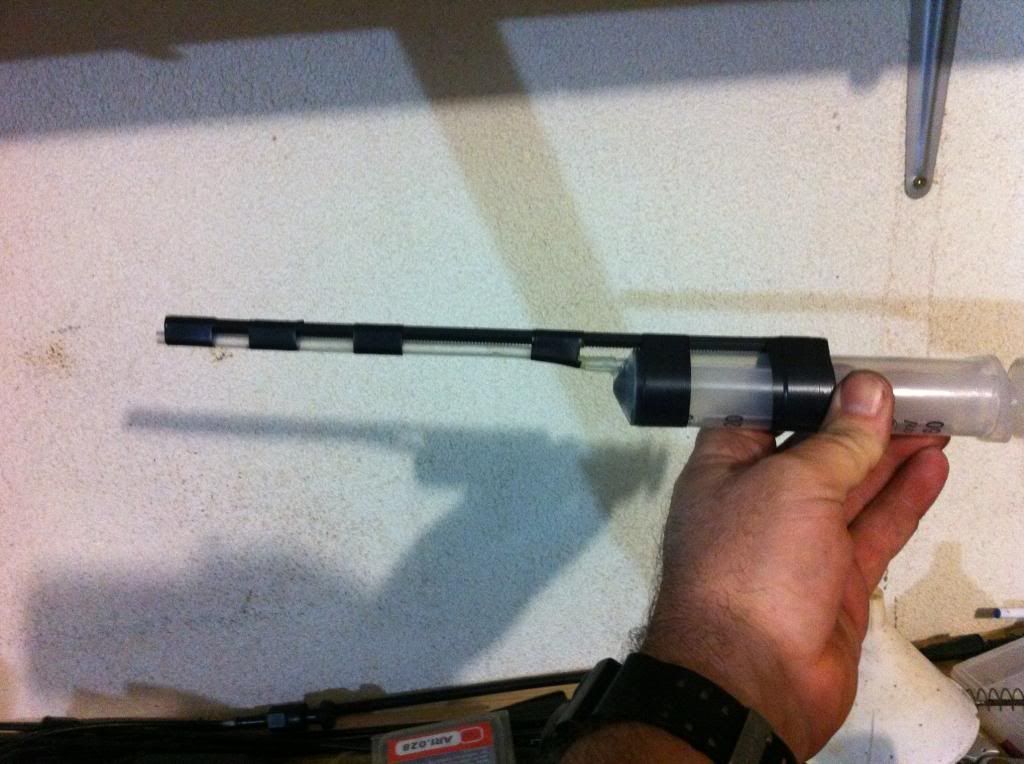
When the dust seals arrive I will slip them over the top of the tubes and reinstall forks on to bike....now where did I put my beer?

Got new seals in with the use of some PVC tube courtesy of the neighbor

With the springs and spacers removed and the forks fully compressed I filled the fork with oil almost to the top. I then inserted my newly made precision tool (I call it the "fork oil level reduction tool")

When the dust seals arrive I will slip them over the top of the tubes and reinstall forks on to bike....now where did I put my beer?
Lane
89 Dark Blue 906 Paso
Ducati Paso, It's an 'understanding'....
89 Dark Blue 906 Paso
Ducati Paso, It's an 'understanding'....
-
lane1feathers
- Posts: 258
- Joined: Thu Sep 20, 2012 11:48 am
- model: 906 Paso
- year: 1989
- Location: Perth, West. Australia
Re: The story so far
Dust seals on, forks back on
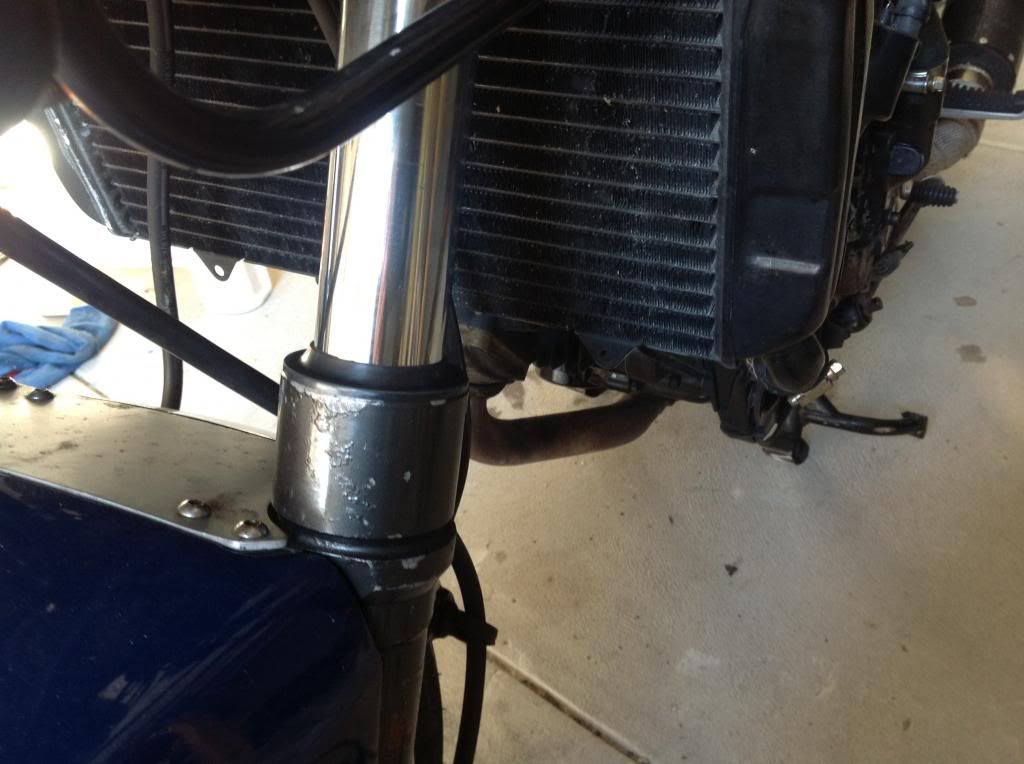
Mikunis in (2nd attempt) with pod filters and even used paso choke cable

I'll be relocating the breather tube tank to a more permanent location. This was taken just after the final ride to make sure it runs with this jetting set up. I haven't balanced the carbs yet.

Mikunis in (2nd attempt) with pod filters and even used paso choke cable

I'll be relocating the breather tube tank to a more permanent location. This was taken just after the final ride to make sure it runs with this jetting set up. I haven't balanced the carbs yet.
Lane
89 Dark Blue 906 Paso
Ducati Paso, It's an 'understanding'....
89 Dark Blue 906 Paso
Ducati Paso, It's an 'understanding'....
-
Andrew2
- paso grand pooh-bah
- Posts: 574
- Joined: Thu Oct 27, 2011 7:47 am
- model: 750 Sport
- year: 1988
- Location: Wollongong,Australia
Re: The story so far
Nice work for a fella without a bench 
Cheers
A2
Cheers
A2
-
Mc tool
- paso grand pooh-bah
- Posts: 1974
- Joined: Wed Dec 05, 2007 12:35 am
- model: 906 Paso
- year: 1990
- Location: Riverton New Zealand
Re: The story so far
You could have painted the fork sliders too 

I wish I was young again............Id be heaps smarter than last time
-
lane1feathers
- Posts: 258
- Joined: Thu Sep 20, 2012 11:48 am
- model: 906 Paso
- year: 1989
- Location: Perth, West. Australia
Re: The story so far
Nah, then they wouldn't match the rest of the bikeMc tool wrote:You could have painted the fork sliders too
I'd have to paint the wheels, frame, motor, grab rail, panels, etc, etc...
......if you look closely......Andrew2 wrote:Nice work for a fella without a bench
Cheers
A2
Lane
89 Dark Blue 906 Paso
Ducati Paso, It's an 'understanding'....
89 Dark Blue 906 Paso
Ducati Paso, It's an 'understanding'....
-
lane1feathers
- Posts: 258
- Joined: Thu Sep 20, 2012 11:48 am
- model: 906 Paso
- year: 1989
- Location: Perth, West. Australia
Re: The story so far
Well, after doing the mikuni conversion I took it for a long ride to see how it would go with the jetting set up. It broke down.....  An hour from home...
An hour from home...
I thought it might be a fuel issue and took it apart on the side of the road, in the rain, and checked everything out and readjusted the fuel mixture screws (now at 3 full turns out with 45 idles) No blocked jets, clean filters, hoses on the right way. I put the tank back on and it started and idled nicely! Not knowing how many starts my battery had left in it, I let it idle as I put all the fairings back on. Just as I was putting the seat on, it stalled. I tried starting it but it wouldn't start. Flattened the battery. I then noticed the temp gauge was on 110 deg. c! but the thermo fan wasn't on. I rang the wife...she came
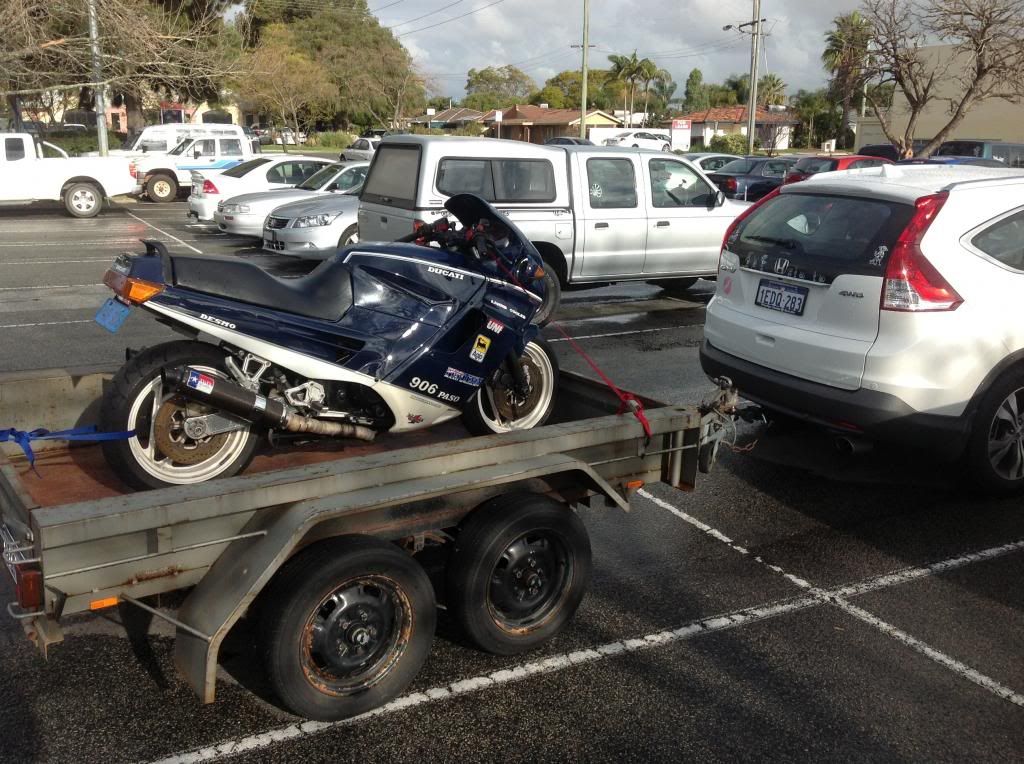
Over the last day or so I've completed the wiring upgrade (John Slocum) by installing a couple of relays. One for the starter and one for the coils. Put both under the seat for easy access and I hate cable tying relays to frame.
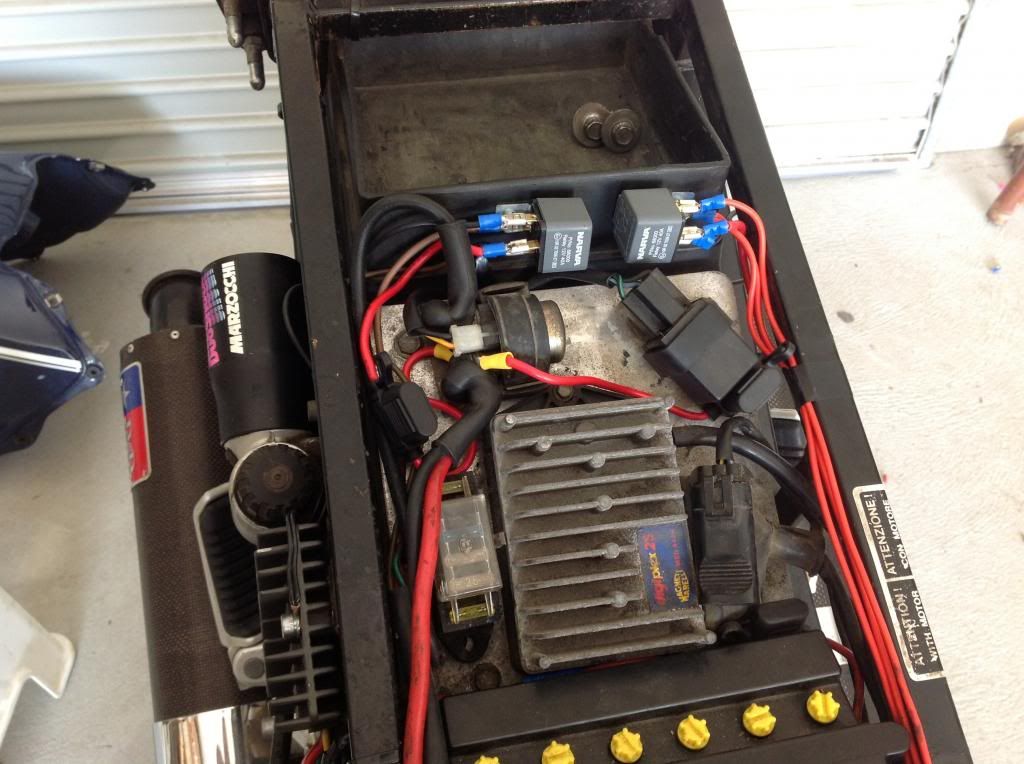
I replaced the battery, checked all connections, turned the key.....nothing...no idiot lights. No power to ignition at all. I went over the wiring diagram trying to figure out what I'd done wrong. All looked good. I followed the John Slocum wiring upgrade to the letter and knew I'd done that right. As I was climbing all over it I noticed (from underneath) that the aluminum tray that has the Digiplex, etc on (that my earth wire bolts to) is bolted to a plastic mudguard!!! So I re routed the earth wires to the side and bolted them with my regulator earth.
I went over the wiring diagram trying to figure out what I'd done wrong. All looked good. I followed the John Slocum wiring upgrade to the letter and knew I'd done that right. As I was climbing all over it I noticed (from underneath) that the aluminum tray that has the Digiplex, etc on (that my earth wire bolts to) is bolted to a plastic mudguard!!! So I re routed the earth wires to the side and bolted them with my regulator earth.
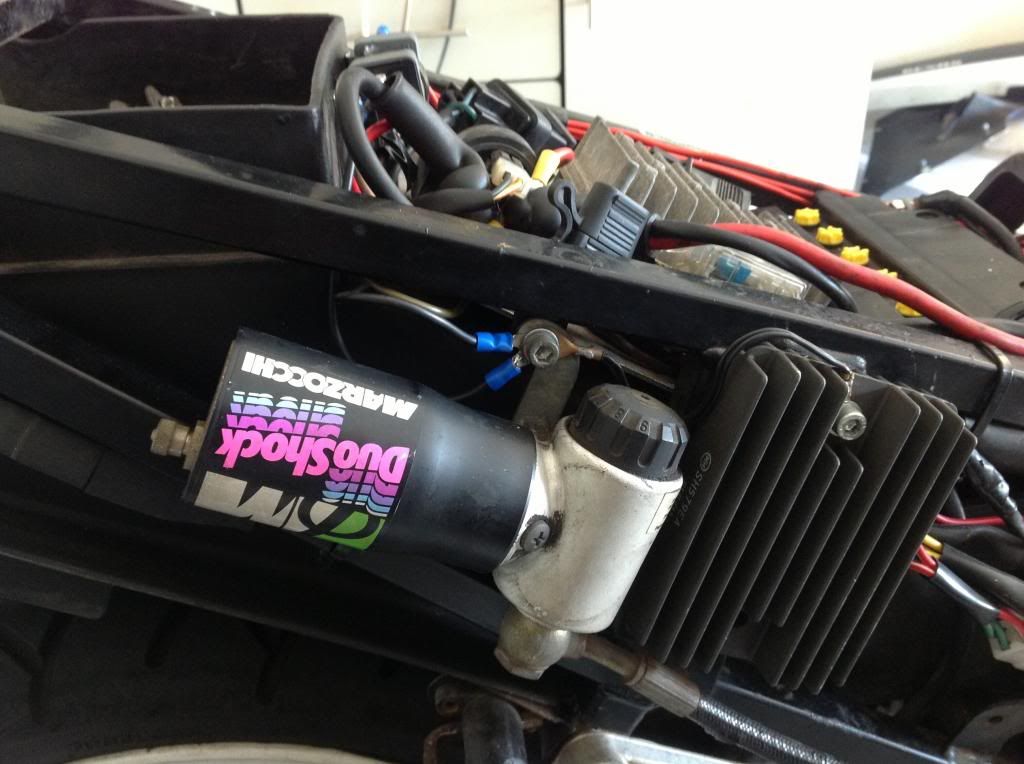
...turned the key....viola...dash lights 906 is obviously different from 750 as JS suggests the indicator relay mounting bolt to be used as the earth placement.
906 is obviously different from 750 as JS suggests the indicator relay mounting bolt to be used as the earth placement.
I put the tank on and fired it up. Idled nicely and revved cleanly. I let it idle for a while to get the temp up to see if fan kicks in. I had also replaced the 2 connections that plug into the thermostatic switch on the cooling hose as they were loose and cracked. Temp got to 100+ then coughed and died. No fan
Ran a pos and a neg wire from battery to fan terminal and it came on. Fan good, thermostatic switch bad. Made the pos/neg wires from the battery permanent, installed an in line fuse then fed them up to the dash and will be installing a on/off switch tomorrow Fan will be operated manually from now on. I like that idea better anyway as it gives me more control in the hot Ozzy summer. These Dukes don't like to run hot it seems.
Fan will be operated manually from now on. I like that idea better anyway as it gives me more control in the hot Ozzy summer. These Dukes don't like to run hot it seems.
I also pulled the ignition switch to see if I'd done any damage but it looked clean and in good condition.
It looks like the stop/start traffic driving with no fan leading up to the failure was the cause of the trouble and the inadequate wiring just got too hot and the spark at the plug was too small to sustain combustion. Tomorrow, with a new switch I'll go for a thrash and see if I'm right. Better hook up the trailer before I go....
I thought it might be a fuel issue and took it apart on the side of the road, in the rain, and checked everything out and readjusted the fuel mixture screws (now at 3 full turns out with 45 idles) No blocked jets, clean filters, hoses on the right way. I put the tank back on and it started and idled nicely! Not knowing how many starts my battery had left in it, I let it idle as I put all the fairings back on. Just as I was putting the seat on, it stalled. I tried starting it but it wouldn't start. Flattened the battery. I then noticed the temp gauge was on 110 deg. c! but the thermo fan wasn't on. I rang the wife...she came

Over the last day or so I've completed the wiring upgrade (John Slocum) by installing a couple of relays. One for the starter and one for the coils. Put both under the seat for easy access and I hate cable tying relays to frame.

I replaced the battery, checked all connections, turned the key.....nothing...no idiot lights. No power to ignition at all.

...turned the key....viola...dash lights
I put the tank on and fired it up. Idled nicely and revved cleanly. I let it idle for a while to get the temp up to see if fan kicks in. I had also replaced the 2 connections that plug into the thermostatic switch on the cooling hose as they were loose and cracked. Temp got to 100+ then coughed and died. No fan
Ran a pos and a neg wire from battery to fan terminal and it came on. Fan good, thermostatic switch bad. Made the pos/neg wires from the battery permanent, installed an in line fuse then fed them up to the dash and will be installing a on/off switch tomorrow
I also pulled the ignition switch to see if I'd done any damage but it looked clean and in good condition.
It looks like the stop/start traffic driving with no fan leading up to the failure was the cause of the trouble and the inadequate wiring just got too hot and the spark at the plug was too small to sustain combustion. Tomorrow, with a new switch I'll go for a thrash and see if I'm right. Better hook up the trailer before I go....
Lane
89 Dark Blue 906 Paso
Ducati Paso, It's an 'understanding'....
89 Dark Blue 906 Paso
Ducati Paso, It's an 'understanding'....
